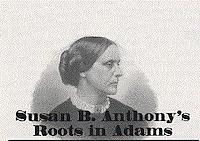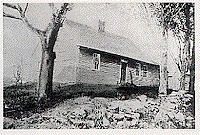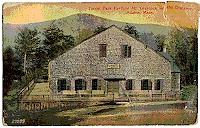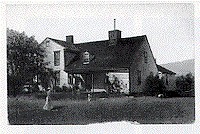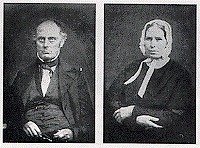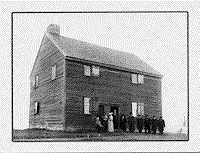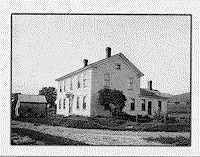Early Life in Adams
by Eugene F. Michalenko
Susan B. Anthony was born in this house in Adams and lived here for just six years of her life. Three generations of the Anthonys had lived in Northern Berkshire and were active in the political, economic and religious life of the area. Her maternal grandparents, born in eastern Massachusetts, were strong characters who were role models to Susan.
On February 15, 1820 a second daughter was born to a young East Road couple. Married about three years earlier after a short engagement, they had known each other since childhood. Lucy Read was the girl next door though the doors were a quarter mile apart. Daniel Anthony was the eldest son of one of the town's wealthier families.
The whole affair was frowned upon because their religions differed. Yet it is the joining of these two dissimilar backgrounds and their Northern Berkshire roots which were the strongest influences of their child, Adams' most famous daughter, Susan B. Anthony.
Six years after her birth Susan left Adams for a lifelong residence in New York. But her family roots were firmly planted here. Her parents and grandparents lived here. Her great grandparents and grandparents were some of the first to settle in East Hoosac and New Providence which later became Adams and Cheshire.
Susan's mother, Lucy, was the second child of Daniel Read and Susannah Richardson. She was born after Daniel returned from the Revolutionary War. He was gone 10 years in a war that lasted but six. While he was away, Susannah ran their farm and raised their eldest daughter alone. Mr. Read was not an ambitious money-maker and the obligation of keeping the family financially solvent was fulfilled by his wife who was more aggressive in accumulating wealth.
The Reads bought 100 acres at Bowen's Corner after Daniel came back from the war. Daniel also returned professing a new belief in Universalism, which denied the existence of hell and believed that all will be saved. He was joined in this belief with his brother-in-law, Sam Bowen who operated a Tavern at Bowens Corners. Bowen and Read spent many hours together at the tavern discussing their shared religious convictions. It is said that Susannah, a Cheshire Baptist, "wore the skin off her knees" praying for her fallen husband.
Early local Baptists were fiery patriots, yearning for independence from England and firmly committed to individual rights. They were political activists who honored two of the more forceful and radical heroes of the American Revolution: Thomas Jefferson to whom Cheshire residents sent the oversized cheese and Samuel Adams who became our town's namesake.
Susan's father, Daniel came from a long line of Quakers: Anthonys and Laphams, who settled the area along East Road and Friend Street. They opposed war, abstained from alcohol and tobacco and generally lived a strict, religious life of simplicity. Education was important - even for women - among this group, also named the Society of Friends. Daniel was educated in New York and although he wanted to stay to become an assistant teacher, his father coaxed him back to Adams by offering the opportunity to teach in a schoolhouse built on the front lawn of their East Road home.
It was in that schoolhouse where the teacher began the relationship with his tall blue-eyed student, Lucy Read. They were married July 13, 1817. Lucy remembered the season and described it to her children as the time "when strawberries were ripe in East Hoosac." She knew life would be restrictive with her devout Quaker husband so before the marriage she said farewell to the worldly life at a gala dancing party that lasted until 4 a.m. Daniel accompanied her and watched her dance with one partner after another. The "adventurous romance," as Susan B. later described it, continued after the marriage when the couple honeymooned across New York state, an incredible journey considering the roads at the time.
Upon their return, they built their house on East Road at the corner of Walling Road on land given them by Mr. Read and with timber Mr. Anthony supplied.
Daniel was visited by a committee of Friends to question his misconduct of marrying outside the religion (he was the first Anthony to do so) and for "dealing in spirituous liquors". He promised to stop selling liquor but he would not be condemned for marrying the woman he loved. But his loyalty to the Quaker faith remained. All his children were raised orthodox Quakers even though his wife never converted.
Susan Brownell Anthony was born in the front downstairs room of the East Road house and named after her father's sister Susannah who had recently married Thomas Brownell. Aunt Susannah died one year after her namesake's birth.
Her father ran a small store which occupied the other front room of the East Road house, continued his teaching and managed farm affairs. His most innovative idea was to build a textile mill on the Tophet Brook. Today one wonders how it provided enough water power for a mill 3 1/2 stories high with a water wheel 26 feet in diameter
Daniel designed, built and managed this pioneer industrial venture. The mill employed farmers' daughters who boarded at the Anthony home. Lucy Anthony's chores now included caring for 11 girls as well as her own family of three daughters. The mill operation attracted the attention of a financial investor from Battenville, New York who lured Daniel Anthony away from Adams to manage a larger textile firm there. In 1826, the Anthonys packed their belongings in several wagons and moved.
Susan returned on several occasions, the last time being in 1897 when she delivered a speech at the Forest Park Pavilion, attended a family reunion and traveled to the top of Mount Greylock.
Although the time she spent in Adams was short, the driving force that motivated Susan B. Anthony was set in motion here. Her work pursuing equality for women was fostered by the strong-minded and independent-thinking family of which she was a part. Although she has not left volumes of literary treasures or a museum of paintings or a financial empire, she leaves inspiration and confidence in the success of justice.
